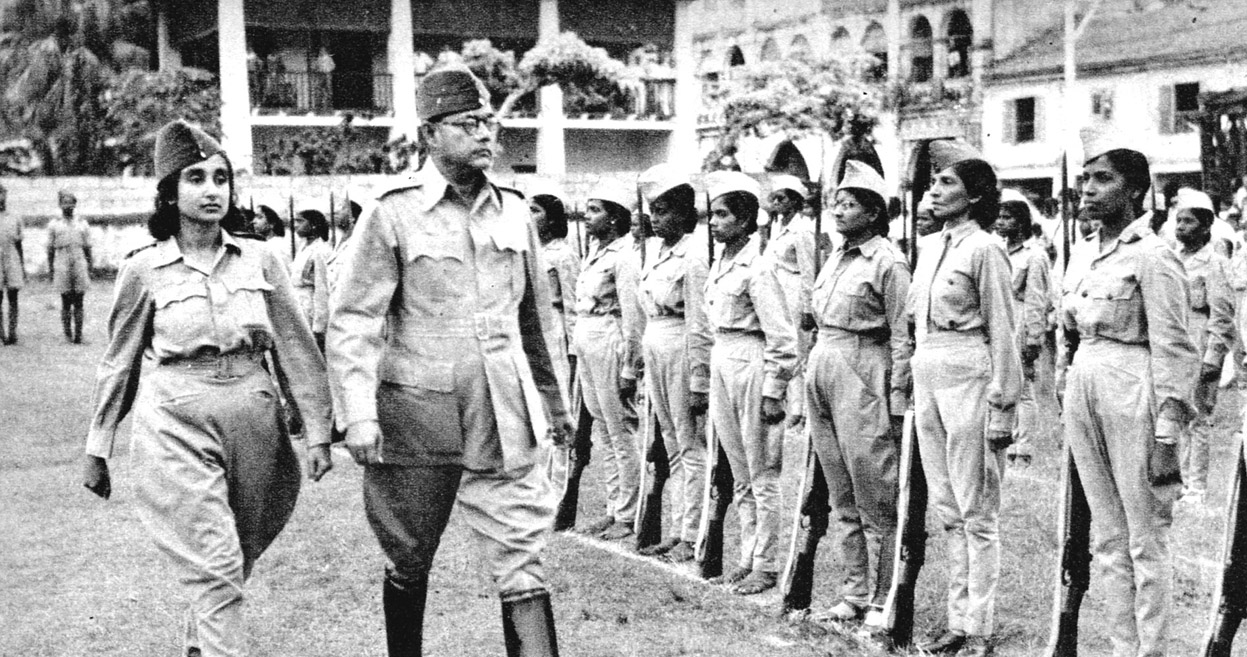.webp)
Saquib Salim
Azad Hind Fauj, or the Indian National Army (INA), led by Subhas Chandra Bose during the Second World War is often perceived through a lens of romanticism rather than historical narratives. Due to this our perception of INA is tinged with myths of heroism and leaves us ignorant of the exceptional planning, diplomacy, and military tactics employed by Bose and the INA.
The INA was fighting against the British-led allied forces in Burma. Although the army was trained for regular combat at the beginning of 1944 it was becoming clear that with less, or no, reinforcement from Japan a regular battle would not be feasible.
The High Command decided to carry out a guerrilla warfare. The INA's medical corps was in charge of chalking out a strategy for guerrilla warfare. It was unprecedented.
Lt. Col. R. M. Kasliwal, head of the medical corps of the INA, drafted a pamphlet in Urdu-Hindi, written in Roman, to teach the medical personnel and soldiers about guerilla warfare. The pamphlet, Guerilla Jangi Karrwaion ke Dauran Men ‘Medical’ ka Intezam, was one of its kind. It breaks the convention that guerilla war is carried out without much planning and even if they are then regular medical missions do not operate during them.
Dr. Kasliwal, at the very outset, wrote, “Guerilla Warfare is different from Regular Warfare. Success in such a Warfare depends largely on the fighting capacity of the troops and as the fighting capacity of the troops depends so much on the health and physical fitness of the troops, the significance of Hygiene and other medical arrangements in such a warfare cannot be ignored.”
Kasliwal explained how regular warfare and guerilla warfare were different. In guerilla war, small bands of armed persons operate from within the enemy territory. “These small bodies of troops are highly mobile and consequently they are lightly armed. Element of surprise is their most effective weapon.”
The pamphlet also explained that a big area to operate in and cooperation from the civilian population were requirements for guerrilla war.
After this, Kasliwal explained the requirements for medical personnel. He said, “For medical arrangements under such conditions it is obvious that the usual stereotyped medical arrangements of the army will not do.”
Factors like adequate medical personnel, medicines and regular evacuation of injured cannot be maintained in guerrilla war. Thus the whole strategy needs to be reworked.
 Captain Laxmi Sehgal and Subhash Chandra Bose walking by the Rani of Jhansi Regiment
Captain Laxmi Sehgal and Subhash Chandra Bose walking by the Rani of Jhansi Regiment
In guerrilla war, troops must be healthy and active under adverse conditions. They must be prepared to deal with lack of clean water, sanitation, medicines, proper food, etc. Kasliwal laid down a few guidelines as follows:
1. The troops should be in sound bodily health both physically and mentally.
2. They should be fully protected (ensure 100 percent.) against the chief infectious diseases prevalent in the operation area e.g. Smallpox, Enteric Group of Fevers, Cholera, Plague, Dysenteries. The protection in the last four diseases only lasts six months so the inoculation must be repeated every 6 month. Smallpox vaccination may be repeated every 1 to 2 years or whenever there is an outbreak of an epidemic.
3. The troops should be trained to undergo tough life, trained in long route marches, sometimes without food and very little water and to be able to do without sleep for at least 48 hours without affecting the efficiency..
4. High spiritual training is essential with the result that the inconveniences met with during Field Service conditions are not taken notice of and troops do not unnecessarily report sick and thus cases of "Psycho-Neurosis" and "Malingering" can be curtailed to a great extent.
5. Training of the troops in general and the officers in particular in the general principles of Hygiene and how to utilize them for protection and maintenance of good health and prevention of diseases.
6. The equipment of the troops should be light and well fitting and it should not exceed 40% of the body weight. Otherwise, there will be an enormous loss of body energy.
Special attention is to be paid to socks and their proper darning and the fitting of boots if casualties from sore feet are to be avoided.
7. Suitable clothing against cold, rain, and summer should be provided. Otherwise, the troops will be put to unnecessary hardships and sickness which could be easily avoided.”
Apart from these, Kasliwal stressed boiling water before consuming, or disinfecting it through any other means, having hygienic food, maintaining sanitation, and using mosquito nets or repellants in forests.
Kasliwal also wrote about the wounded soldiers, “Whenever it is possible to send a message to H.Q., it will be necessary to send full details of these cases which are being left behind with exact location of the place so that when facilities are available, arrangements may be made by H.Q. to contact these cases and if possible to evacuate them to Base Hospital. If in a zone of operation, an Aerodrome is captured, it may sometimes be possible to evacuate severe cases by AIR, but then again it is going to be very rare and could hardly be depended on.
If the enemy resorts to Gas Warfare or even Bacterial Warfare to small limited localities, the M.O. will tackle the situation according to the nature of the organism or the gas used and devise ways and means to combat it successfully. Bleach ointment will be issued for treatment against mustard gas poisoning.”
ALSO READ: Empowered Muslim woman is no threat to religion
The pamphlet is important in telling us that the INA was not a band of zealous hot-headed patriots but they were a well-planned group of nationalists who knew the art of warfare as well as anybody else. It also tells us that every move of the INA was well thought out and tried to minimize the casualty.
